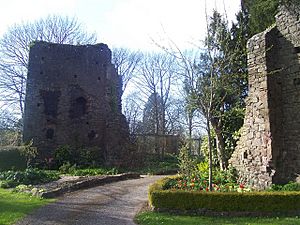John Courtenay, 15th Earl of Devon facts for kids
Quick facts for kids Sir John Courtenay |
|
|---|---|
 |
|
| Ruins of Tiverton Castle, a former home of the Earls of Devon | |
| Noble family | Courtenay |
| Father | Thomas Courtenay, 13th Earl of Devon |
| Mother | Margaret Beaufort |
| Born | c. 1435 |
| Died | 4 May 1471 Tewkesbury, England |
Sir John Courtenay (born around 1435 – died 4 May 1471) was an important figure during the Wars of the Roses. He was the third son of Thomas Courtenay, 13th Earl of Devon and Margaret Beaufort. After his older brother was executed, some people who supported the House of Lancaster (one of the two sides in the Wars of the Roses) called John Courtenay the Earl of Devon.
Family Background
John Courtenay was born around 1435. His father was Thomas Courtenay, 13th Earl of Devon. His mother, Margaret Beaufort, was the daughter of John Beaufort, 1st Earl of Somerset. This meant John was a great-great-grandson of King Edward III through his mother's side.
John had two older brothers and five sisters:
- Thomas Courtenay, 14th Earl of Devon (1432 – 3 April 1461). He was captured after the Battle of Towton and executed. He had no children.
- Henry Courtenay (died 17 January 1469). He was executed in Salisbury.
- Joan Courtenay (born around 1447). She married Sir Roger Clifford and later Sir William Knyvet.
- Elizabeth Courtenay (born around 1449). She married Sir Hugh Conway.
- Anne Courtenay.
- Eleanor Courtenay.
- Maud Courtenay.
John Courtenay's Life
John Courtenay was originally expected to join the church. However, his life took a different path. His brother, Thomas Courtenay, knighted him after the Battle of Wakefield. This was a major battle in the Wars of the Roses.
Challenges and Exile
After the Battle of Mortimer's Cross, the future King Edward IV of England took control of London. The Parliament then declared John Courtenay a traitor. This meant he lost his family's lands and titles. The Earldom of Devon, which had been passed down for generations, was put on hold.
King Edward IV secured his rule with a big victory at the Battle of Towton. After this battle, John's brother was executed. Around 1465, John Courtenay went into exile in France. He was with Queen Margaret of Anjou, who was the wife of the deposed King Henry VI of England. From 1469, he was known as the "titular" Earl of Devon by the Lancastrians. This meant he held the title in name, but didn't fully control the lands.
Return and Final Battle
When King Henry VI was briefly put back on the throne in October 1470, John Courtenay got his family's lands back. These lands had been given to John Neville, 1st Marquess of Montagu by King Edward IV. However, John Courtenay didn't gain much political power. He was only given one small role in Devon.
In 1471, King Edward IV returned to England to fight for his throne again. John Courtenay was in London with King Henry VI and Edmund Beaufort, Duke of Somerset. They left London to meet Queen Margaret of Anjou and her son, Edward of Westminster, Prince of Wales, who were coming back from France. This move stopped another Lancastrian plan.
King Edward IV then took London and captured King Henry VI. The main Lancastrian leader, Richard Neville, Earl of Warwick, was defeated and killed at the Battle of Barnet on April 14.
Queen Margaret landed in England two days later. She met John Courtenay and the Duke of Somerset. They told her their cause was "far from lost." They were given permission to raise an army in the southwest of England. John Courtenay gathered soldiers from Devon, which was his family's traditional base.
They marched to join other Lancastrian forces. However, King Edward IV intercepted them. They fought at the Battle of Tewkesbury on 4 May 1471. John Courtenay led the Lancastrian left side of the army. He was killed during the battle when his division fled. He was buried at Tewkesbury Abbey churchyard with other nobles who died that day.

